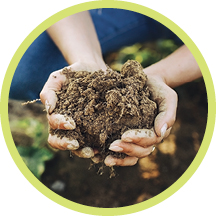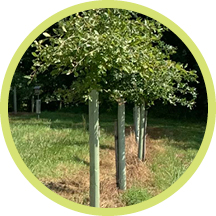Tree Planting Incentive Programs
Main_Content

FARMERS: Are you ready to grow your income and enhance your farm's natural resources? Our tree-planting incentives support a range of agroforestry practices that
integrate farming and forestry. These practices can help you
generate additional farm income, create
healthier conditions for livestock and crops, and
promote cleaner air and streams. Please scroll down to explore our programs.

Conservation Buffer Initiative
This program offers farmers
attractive incentive payments to plant streamside buffers to improve the health of local streams and the Chesapeake Bay. Farmers can receive
up to $4,500 an acre to install a riparian forest buffer with pasture fencing. Riparian forest buffers also qualify for a one-time BONUS PAYMENT of $1,000/acre. You can apply for this program by contacting your soil conservation district during its annual open enrollment period which runs from November 1, 2025 through April 30, 2026.
Learn more about the Conservation Buffer Initiative.
 CREP
CREP
Maryland’s Conservation Reserve Enhancement Program (CREP) is a federal-state partnership program that pays farmers and rural landowners attractive land rental rates to remove environmentally sensitive agricultural land out of production for 10-15 years and install conservation practices to protect
streams and create wildlife habitat. Farmers who plant new riparian forest buffers next to streams qualify for a one-time BONUS PAYMENT of $1,000/acre. Please contact your local USDA Farm Service Agency office to apply. Learn more about CREP.
 Healthy Soils Competitive Fund
Healthy Soils Competitive Fund
This competitive grant program awards selected applicants with up to $50,000 to support 3 years of enhanced soil health practices. Agroforestry practices to improve soil health and build climate resilience are a great fit. You can apply for these grants during the program's open enrollment period, which typically begins in January and runs for approximately 8 weeks.
Examples of popular tree planting practices include alley cropping and critical area plantings.
Please visit the Please visit the Healthy Soils website to learn more.
 Riparian Forest Buffer
Riparian Forest Buffer
Planting trees and shrubs along waterways helps filter runoff, enhance water quality, control erosion, and create wildlife habitat. Riparian forest buffers also provide essential shade to cool streams for trout and other aquatic animals. The Maryland Agricultural Water Quality Cost-Share (MACS) Program offers farmers up to 100% cost-share funding to plant riparian forest buffers, including $2 for each tree planted. Please contact your local soil conservation district to apply for this grant.
 Hedgerow Planting
Hedgerow Planting
Small trees, shrubs, and grasses planted along the
edges of farm fields or roads filter runoff and act as a living fence and wildlife corridor. Hedgerows protect air and water quality, reduce noise, provide shelter for wildlife, and can improve your farm’s aesthetic value. This practice is funded by the Maryland Agricultural Water Quality Cost-Share (MACS) Program. MACS provides
up to 100% cost-share to plant the hedgerow and an
additional $2 per planted tree. Please contact your local soil conservation district to apply for this grant.
 Silvopasture
Silvopasture
Introducing trees into active livestock pastures helps
improve soil and water quality, filters runoff, provides shade and shelter for livestock, and captures carbon from the atmosphere.
This practice is funded by the Maryland Agricultural Water Quality Cost-Share (MACS) Program. MACS pays
up to 87.5% cost-share to install this practice
plus $2 per planted tree. Please contact your local Please contact your local soil conservation district to apply for this grant.
Tree & Shrub Establishment 
Establishing trees and shrubs on agricultural land outside the stream corridor improves water quality and captures carbon from the atmosphere. This practice can be applied on any site capable of growing woody plants, including land in conservation programs sponsored by USDA, other federal and state agencies, and private organizations. This practice is funded by the Maryland Agricultural Water Quality Cost-Share (MACS) Program. MACS provides up to 100% cost-share to install this practice and an
additional $2 per planted tree. Please contact your local Please contact your local soil conservation district to apply for this grant.
 Windbreak Establishment
Windbreak Establishment
Trees and shrubs planted in rows near chicken houses,
barnyard areas, and property borders improve air quality, create visual screens, protect against winter winds, and provide shade and habitat for wildlife. This practice is funded by the Maryland Agricultural Water Quality Cost-Share (MACS) Program. MACS offers
up to 100% cost-share for this practice and
$2 per planted tree. Please contact your local soil conservation district to apply for this grant.